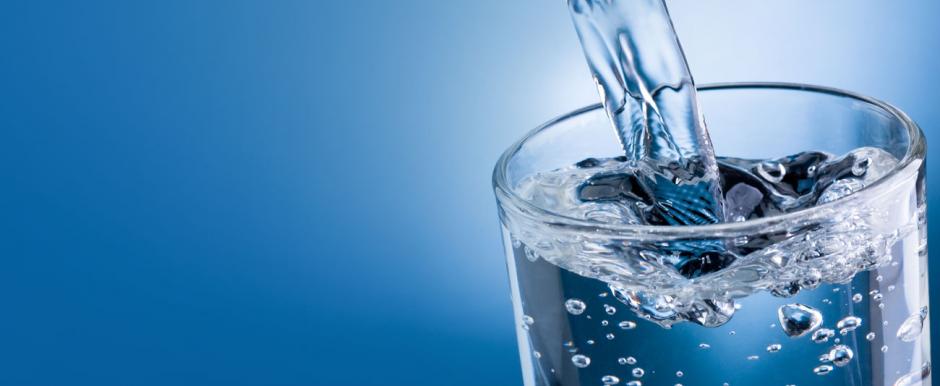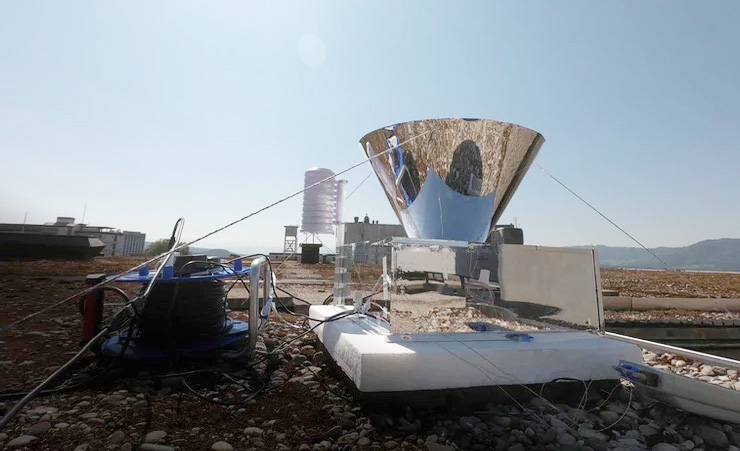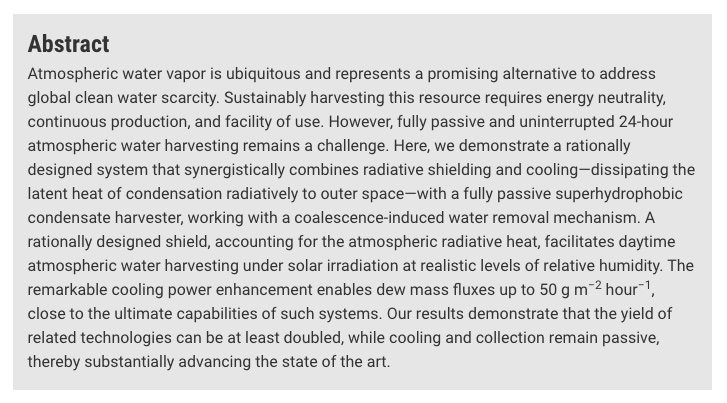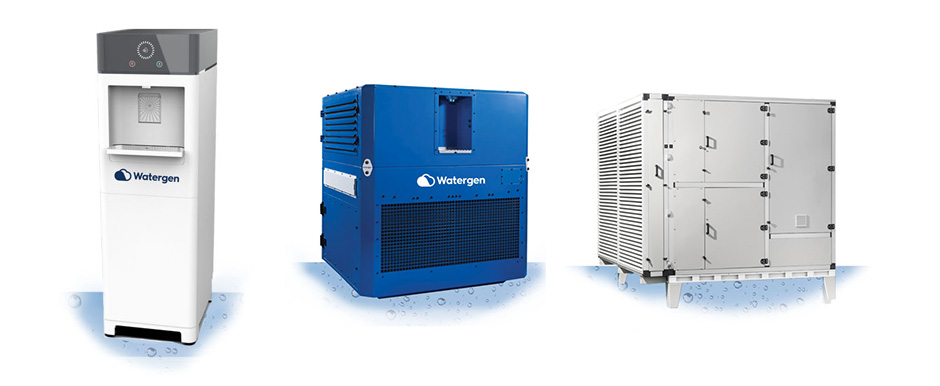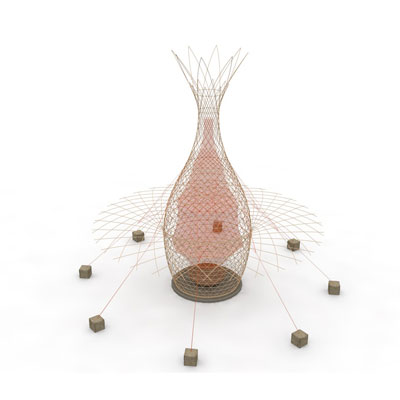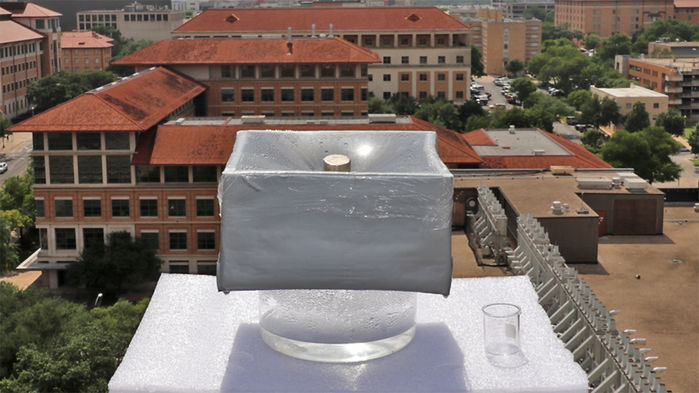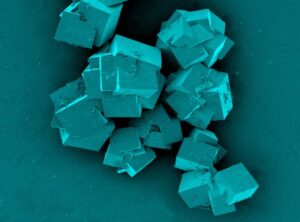Recent Articles:
• Israeli Tech Company Making Water From Air Gets Top Honor In Las Vegas
• Scientists Are Harvesting Water By Building Fog Harps And Zapping The Air
• This Device Sucks Drinking Water Out Of Dry Desert Air, Powered Only By The Sun
• Solar-Powered Desalination Device Will Provide Clean Water To 400,000 Kenyans (The Brighter Side – 10/11/21)
• Portable Device Converts Seawater To Drinking Water At The Push Of A Button (Brighter Side Of News – 06/11/22)
………………
WaterCube – Atmospheric Water Generator For Home
………………
Spout
………………
New Technology Harvests Water From The Air, 24 Hours A Day, With No Energy Input
Researchers at ETH Zurich have now developed a technology that, for the first time, allows them to harvest water 24 hours around the clock, with no energy input, even under the blazing sun. The new device essentially consists of a specially coated glass pane, which both reflects solar radiation and also radiates away its own heat through the atmosphere to the outer space. It thus cools itself down to as much as 15 degrees Celsius (59 degrees Fahrenheit) below the ambient temperature. On the underside of this pane, water vapour from the air condenses into water. The process is the same as can be observed on poorly insulated windows in winter…
As tests of the new device under real-world conditions on the roof of an ETH building in Zurich showed, the new technology can produce at least twice as much water per area per day as the best current passive technologies based on foils: the small pilot system with a pane diameter of 10 centimetres delivered 4.6 millilitres of water per day under real-world conditions. Larger devices with larger panes would produce more water accordingly. The scientists were able to show that, under ideal conditions, they could harvest up to 0.53 decilitres (approximately 1.8 fluid ounces) of water per square metre of pane surface per hour. “This is close to the theoretical maximum value of 0.6 decilitres (2.03 ounces) per hour, which is physically impossible to exceed,” says Iwan Hächler. He is a doctoral student in the group of Dimos Poulikakos, Professor of Thermodynamics at ETH Zurich.
Other technologies usually require the condensed water to be wiped from a surface, which requires energy. Without this step, a significant portion of the condensed water would cling to the surface and remain unusable while hindering further condensation. The ETH Zurich researchers applied a novel superhydrophobic (extremely water-repellent) coating to the underside of the pane in their water condenser. This causes the condensed water to bead up and run or jump off on its own accord. “In contrast to other technologies, ours can really function without any additional energy, which is a key advantage,” Hächler said.
The researchers’ goal was to develop a technology for countries with water scarcity and, in particular, for developing and emerging countries. Now, they say, other scientists have the opportunity to further develop this technology or combine it with other methods, such as water desalination, to increase their yield. The production of the coated panes is relatively simple and building water condensers that are larger than the current pilot system ought to be possible. Similar to the way solar cells feature several modules set up next to each other, several water condensers could also be positioned side by side to piece together a large-scale system.
…
Exploiting Radiative Cooling For Uninterrupted 24-Hour Water Harvesting From The Atmosphere
By Haechler I, Park H, Schnoering G, Gulich T, Rohner M, Tripathy A, Milionis A, Schutzius TM, Poulikakos D
ScienceAdvances
June 23, 2021
………………
Zero Mass Water
………………
WaterGen
Israeli Tech Company Making Water From Air Gets Top Honor In Las Vegas
GENNY, the Israeli-innovated home appliance that generates water out of thin air, was named the Consumer Technology Association’s Energy Efficiency Product of the Year in the 2020 Smart Home Mark of Excellence Awards at the Consumer Electronics Show (CES) in Las Vegas Wednesday night — an award series that annually recognizes the tech industry’s top smart home innovations.
Created by the environmentally savvy Rishon Lezion-based tech company Watergen, the water-from-air system taps into atmospheric water using patented heat-exchange technology, producing up to 30 liters of potable water for a home or office every day — significantly reducing plastic usage and disposal by eliminating the waste caused by drinking bottled water.
How exactly does the system work? First, Watergen’s built-in blower draws air into the system’s atmospheric water generator. There, an internal filter cleans the air by removing dust and dirt. Once clean, the air is directed through the GENius heat exchange and cooling process, and condensed into water.
The water is then filtered again to remove impurities and add minerals, resulting in fresh, drinking-quality water. Once produced, the water is continuously circulated in a built-in reservoir to preserve its freshness.
The water produced by GENNY is therefore of a higher quality than water running through filtration systems attached to municipal water lines. GENNY also has the potential to serve as an air purifier, circulating clean air throughout homes through a small tweak in the water generation process, using the already existing technology to create a multipurpose product.
“Our company’s mission is to eliminate the need to rely on outside sources for life necessities and to help people become more environmentally friendly,” said Dan Clifford, president of Watergen North America. “We are especially honored to be named Energy Efficiency Product of the Year at this year’s CES show, because this award directly supports one of the top values Watergen stands for.”
The company, chaired by Israeli-Georgian businessman and philanthropist Mikhael Mirilashvili, recently set its sights on expanding its renewable and energy-efficient clean water solution to the 2.1 billion people worldwide who lack access to safe water at home — and wherever else it might be needed.
Last year, the company’s large-scale system was donated to authorities in Brazil, Vietnam and India. It also assisted rescue and recovery efforts during the 2018 California wildfires and provided clean water to the residents of Texas and Florida in the aftermath of the devastation caused by hurricanes Harvey and Irma.
The large-scale version, called Gen-L, can produce up to 5,000 liters of clean water a day, requiring no infrastructure other than a standard electricity supply. According to the company’s website, it is “perfect for villages, off-grid settlements and factories.” While the technology is now firmly focused on tackling the global water shortage, the company has maintained the energy-efficient edge of its early-day designers and boasts the world’s most energy-efficient atmospheric water production system.
“My first priority is not how to make money but to help people, the planet and make [a] kiddush hashem [sanctification of God’s name],” Mirilashvili told The Jerusalem Post. “Regarding the revenues, only God decides who makes money and how much.”
• WaterGen Website
• WaterGen on Facebook
• WaterGen on YouTube
………………
Skywater
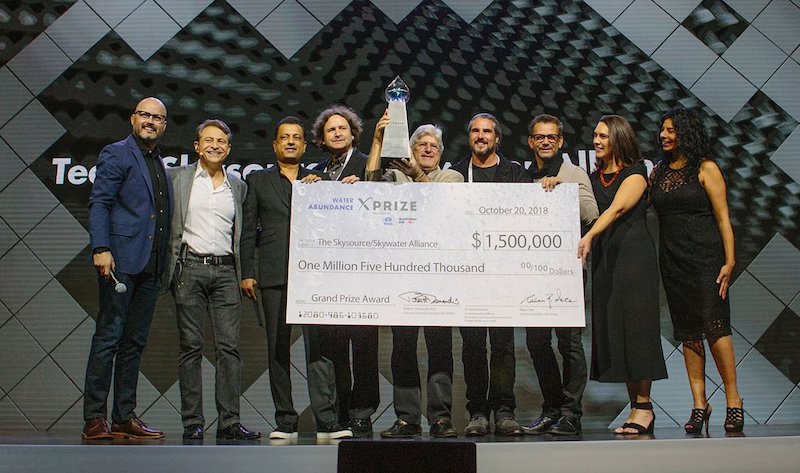
Skywater Wins XPrize
During Visioneering 2018, XPRIZE’s annual gathering of philanthropists and innovators to evaluate concepts for future competitions, the Foundation revealed the results of its latest, completed XPRIZE. The Skysource / Skywater Alliance was announced as the grand prize winner of the $1.75M Water Abundance XPRIZE, a two-year competition aimed at alleviating the global water crisis with energy-efficient technologies that harvest fresh water from thin air. 97 teams from 27 countries participated in the competition.
The Water Abundance XPRIZE, powered by the Tata Group and Australian Aid, was launched in 2016 at the United Nations in New Delhi. The Skysource / Skywater Alliance, based in Venice Beach, California, received a grand prize of $1.5M for developing an easily deployable high-volume water generator that can be used in any climate, meeting the competition parameters of extracting a minimum of 2,000 liters of water per day from the atmosphere using 100 percent renewable energy, at a cost of no more than two cents per liter. A second team, JMCC WING, based in South Point, Hawaii, received a $150K prize to acknowledge the team’s ingenuity in developing a unique technological approach.
………………
• The Skysource / Skywater Alliance
• JMCC WING
………………
This Machine Can Make Gallons Of Fresh Drinking Water Right Out Of Thin Air
By Doug Criss
CNN
October 25, 2018
Machines designed by a California-based team can produce, in some cases, up to 300 gallons of fresh drinking water a day by pulling it straight from the air. And the team just won a $1.5 million prize for it.
The machines, dubbed Skywater, were created by the Skysource/Skywater Alliance, a team of sustainability experts from Venice, California. Skywater machines, housed in big metal boxes, are atmospheric water generators that condense water vapor from the atmosphere and turn it into drinking water. The machines can be powered by solar energy or the burning of biofuels. Depending on the model, they can be used for households, for farming or for emergency relief efforts.
The prize, called the Water Abundance XPRIZE, was awarded Saturday by XPRIZE, a California nonprofit that runs competitions with sometimes multimillion dollars in prize money aimed at creating solutions for the world’s problems. The Water Abundance XPRIZE was a two-year competition that sought to find answers to the global water crisis by facilitating the development of new technologies.
David Hertz, one of leaders of the Skysource/Skywater Alliance, says he’s excited about what the Skywater machines could do for people living in parts of the world where water is becoming more scarce.
“I’ve just been very, very interested in water … but also the importance of fresh water to mankind,” Hertz, an architect who specializes in constructing sustainable buildings, says in a video on the team’s website. “And in being in California, the issues are fast approaching crisis proportions.”
Hertz says there’s more than enough water vapor in the air from which the machines can extract to produce gallons of water every day. Hertz estimates there’s about “37.5 million billion gallons of water” in the atmosphere at any given time, which Skysource says is more fresh water than in all the rivers on Earth.
………………
………………
………………
Warka Water
………………
………………
………………
• Warka Water Website
• Warka Water on Facebook
• Warka Water on Twitter
• Warka Water Photos
• Warka Water on YouTube
………………
THIS TOWER PULLS DRINKING WATER OUT OF THIN AIR
By Tuan C. Nguyen
smithsonian.com
April 8, 2014
In some parts of Ethiopia, finding potable water is a six-hour journey.
People in the region spend 40 billion hours a year trying to find and collect water, says a group called the Water Project. And even when they find it, the water is often not safe, collected from ponds or lakes teeming with infectious bacteria, contaminated with animal waste or other harmful substances.
The water scarcity issue — which affects nearly 1 billion people in Africa alone — has drawn the attention of big-name philanthropists like actor and Water.org co-founder Matt Damon and Microsoft co-founder Bill Gates, who, through their respective nonprofits, have poured millions of dollars into research and solutions, coming up with things like a system that converts toilet water to drinking water and a “Re-invent the Toilet Challenge,” among others.
Critics, however, have their doubts about integrating such complex technologies in remote villages that don’t even have access to a local repairman. Costs and maintenance could render many of these ideas impractical.
“If the many failed development projects of the past 60 years have taught us anything,” wrote one critic, Toilets for People founder Jason Kasshe, in a New York Times editorial, “it’s that complicated, imported solutions do not work.”
Other low-tech inventions, like this life straw, aren’t as complicated, but still rely on users to find a water source.
It was this dilemma — supplying drinking water in a way that’s both practical and convenient — that served as the impetus for a new product called Warka Water, an inexpensive, easily-assembled structure that extracts gallons of fresh water from the air.
The invention from Arturo Vittori, an industrial designer, and his colleague Andreas Vogler doesn’t involve complicated gadgetry or feats of engineering, but instead relies on basic elements like shape and material and the ways in which they work together.
At first glance, the 30-foot-tall, vase-shaped towers, named after a fig tree native to Ethiopia, have the look and feel of a showy art installation. But every detail, from carefully-placed curves to unique materials, has a functional purpose.
The rigid outer housing of each tower is comprised of lightweight and elastic juncus stalks, woven in a pattern that offers stability in the face of strong wind gusts while still allowing air to flow through. A mesh net made of nylon or polypropylene, which calls to mind a large Chinese lantern, hangs inside, collecting droplets of dew that form along the surface. As cold air condenses, the droplets roll down into a container at the bottom of the tower. The water in the container then passes through a tube that functions as a faucet, carrying the water to those waiting on the ground.
Using mesh to facilitate clean drinking water isn’t an entirely new concept. A few years back, an MIT student designed a fog-harvesting device with the material. But Vittori’s invention yields more water, at a lower cost, than some other concepts that came before it.
“[In Ethiopia], public infrastructures do not exist and building [something like] a well is not easy,” Vittori says of the country. “To find water, you need to drill in the ground very deep, often as much as 1,600 feet. So it’s technically difficult and expensive. Moreover, pumps need electricity to run as well as access to spare parts in case the pump breaks down.”
So how would Warka Water’s low-tech design hold up in remote sub-Saharan villages? Internal field tests have shown that one Warka Water tower can supply more than 25 gallons of water throughout the course of a day, Vittori claims. He says because the most important factor in collecting condensation is the difference in temperature between nightfall and daybreak, the towers are proving successful even in the desert, where temperatures, in that time, can differ as much as 50 degrees Fahrenheit.
The structures, made from biodegradable materials, are easy to clean and can be erected without mechanical tools in less than a week. Plus, he says, “once locals have the necessary know-how, they will be able to teach other villages and communities to build the Warka.”
In all, it costs about $500 to set up a tower — less than a quarter of the cost of something like the Gates toilet, which costs about $2,200 to install and more to maintain. If the tower is mass produced, the price would be even lower, Vittori says. His team hopes to install two Warka Towers in Ethiopia by next year and is currently searching for investors who may be interested in scaling the water harvesting technology across the region.
“It’s not just illnesses that we’re trying to address. Many Ethiopian children from rural villages spend several hours every day to fetch water, time they could invest for more productive activities and education,” he says. “If we can give people something that lets them be more independent, they can free themselves from this cycle.”
………………
………………
Other Warka Water Articles:
• Handwoven Dew Collecting Tower Aims To Ease Africa’s Water Crisis
• This Tower Pulls Drinking Water Out of Thin Air
• The 30ft High Bamboo ‘Flower Basket’ That Can Pluck Drinking Water From Thin Air
• A Giant Basket That Uses Condensation to Gather Drinking Water
………………
WaterSeer
• WaterSeer Website
• WaterSeer Blog
………………
Drought Masters
………………
Clean Water Foundation
• Creating Water Foundation Website
………………
Hector Pino’s Fresh Water Machine
• Fresh Water Solutions Website
………………
Professor Omar Yaghi & MOF Technology
• Learn more about Omar Yaghi & MOF Technology
………………
New Solar Technology Could Produce Clean Drinking Water For Millions In Need
By Robert F. Service
June 28, 2019
Tanklike devices called solar stills use the sun to evaporate dirty or salty water and condense the vapor into safe drinking water. But large, expensive stills can only produce enough water for a small family. Now, researchers have developed a new material that speeds the process of evaporation, enabling a small solar still to provide all the drinking water one family needs. If the technology proves cheap enough, it could provide millions of impoverished people access to clean drinking water.
Today 783 million, or nearly one in 10, people around the world lack such access, according to UNICEF. These people spend a collective 200 million hours a day fetching water from distant sources. And even though technologies exist for purifying contaminated water and desalinating seawater, these typically require expensive infrastructure and lots of energy, putting them beyond the reach of many communities.
Recently, researchers have been working to upgrade solar stills as a cheap, low-tech alternative. The traditional still is little more than a black-bottomed vessel filled with water and topped with clear glass or plastic. The black bottom absorbs sunlight, heating water so that it evaporates and leaves the contaminants behind. The water vapor then condenses on the clear covering and trickles into a collector.
But the output is low because the sun’s rays must heat the entire volume of water before evaporation begins. Commercially available versions produce about 0.3 liters of water per hour per square meter (L/h/m2) of the covered water’s surface area. The average person requires about 3 liters of water a day for drinking. Providing enough drinking water for a small family requires a still around 5 square meters in size. Operating at their theoretical best, such devices can only produce 1.6 L/h/m2.
Guihua Yu, a materials scientist at the University of Texas in Austin, and colleagues recently reported a way around this limit. It involves hydrogels, polymer mixtures that form a 3D porous, water—absorbent network. Yu and colleagues fashioned a gellike sponge of two polymers—one a water-binding polymer called polyvinyl alcohol (PVA), the other a light absorber called polypyrrole (PPy)—which they then placed atop the water’s surface in a solar still.
Inside the gel, a layer of water molecules bonded tightly to the PVA, each forming multiple chemical links known as hydrogen bonds. But with so much of their bonding ability tied up with the PVA, the bound water molecules bind only loosely to other nearby water molecules, creating what Yu calls “intermediate water.” Because intermediate water molecules share fewer bonds with their neighbors, they evaporate more readily than regular water. And when they do, they’re immediately replaced by other water molecules in the still. Using this technology, Yu’s solar still produced 3.2 L/h/m2 of water, double the theoretical limit, his team reported last year in Nature Nanotechnology.
Now, Yu and his colleagues have created an even better hydrogel. They mixed in a third polymer, called chitosan, which also strongly attracts water. Adding chitosan to the mix created a gel that could hold more water—and increased the amount of intermediate water as a result. A still using the new hydrogel distilled water at a rate of 3.6 L/h/m2, the highest rate ever reported and about 12 times the amount produced by today’s commercially available versions, the researchers report today in Science Advances.
“This is a fantastic starting point,” says Peng Wang, an environmental engineer at King Abdullah University of Science and Technology in Thuwal, Saudi Arabia. Wang notes that at this higher water production rate, a solar still 1 square meter in size could produce about 30 liters of clean drinking water per day, enough for a small family. Even better, he says, all three polymers in the hydrogel are both commercially available and cheap. That means that if the stills using them are rugged enough, they could help provide clean water for those who need it most.
………………
QuenchSea
• QuenchSea Website
• QuenchSea on Indiegogo
………………
• We Might Finally Be Able to Safely Drink Salt Water
………………
Portable Device Converts Seawater To Drinking Water At The Push Of A Button
Brighter Side Of News
June 11, 2022
MIT researchers have developed a portable desalination unit, weighing less than 10 kilograms, that can remove particles and salts to generate drinking water.
The suitcase-sized device, which requires less power to operate than a cell phone charger, can also be driven by a small, portable solar panel, which can be purchased online for around $50. It automatically generates drinking water that exceeds World Health Organization quality standards. The technology is packaged into a user-friendly device that runs with the push of one button.
Unlike other portable desalination units that require water to pass through filters, this device utilizes electrical power to remove particles from drinking water. Eliminating the need for replacement filters greatly reduces the long-term maintenance requirements.
This could enable the unit to be deployed in remote and severely resource-limited areas, such as communities on small islands or aboard seafaring cargo ships. It could also be used to aid refugees fleeing natural disasters or by soldiers carrying out long-term military operations.
“This is really the culmination of a 10-year journey that I and my group have been on. We worked for years on the physics behind individual desalination processes, but pushing all those advances into a box, building a system, and demonstrating it in the ocean, that was a really meaningful and rewarding experience for me,” says senior author Jongyoon Han, a professor of electrical engineering and computer science and of biological engineering, and a member of the Research Laboratory of Electronics (RLE).
Joining Han on the paper are first author Junghyo Yoon, a research scientist in RLE; Hyukjin J. Kwon, a former postdoc; SungKu Kang, a postdoc at Northeastern University; and Eric Brack of the U.S. Army Combat Capabilities Development Command (DEVCOM). The research has been published online in Environmental Science and Technology.
Commercially available portable desalination units typically require high-pressure pumps to push water through filters, which are very difficult to miniaturize without compromising the energy-efficiency of the device, explains Yoon.
Instead, their unit relies on a technique called ion concentration polarization (ICP), which was pioneered by Han’s group more than 10 years ago. Rather than filtering water, the ICP process applies an electrical field to membranes placed above and below a channel of water. The membranes repel positively or negatively charged particles — including salt molecules, bacteria, and viruses — as they flow past. The charged particles are funneled into a second stream of water that is eventually discharged.
The process removes both dissolved and suspended solids, allowing clean water to pass through the channel. Since it only requires a low-pressure pump, ICP uses less energy than other techniques.
But ICP does not always remove all the salts floating in the middle of the channel. So the researchers incorporated a second process, known as electrodialysis, to remove remaining salt ions.
Yoon and Kang used machine learning to find the ideal combination of ICP and electrodialysis modules. The optimal setup includes a two-stage ICP process, with water flowing through six modules in the first stage then through three in the second stage, followed by a single electrodialysis process. This minimized energy usage while ensuring the process remains self-cleaning.
“While it is true that some charged particles could be captured on the ion exchange membrane, if they get trapped, we just reverse the polarity of the electric field and the charged particles can be easily removed,” Yoon explains.
They shrunk and stacked the ICP and electrodialysis modules to improve their energy efficiency and enable them to fit inside a portable device. The researchers designed the device for nonexperts, with just one button to launch the automatic desalination and purification process. Once the salinity level and the number of particles decrease to specific thresholds, the device notifies the user that the water is drinkable.
The researchers also created a smartphone app that can control the unit wirelessly and report real-time data on power consumption and water salinity.
After running lab experiments using water with different salinity and turbidity (cloudiness) levels, they field-tested the device at Boston’s Carson Beach.
Yoon and Kwon set the box near the shore and tossed the feed tube into the water. In about half an hour, the device had filled a plastic drinking cup with clear, drinkable water.
“It was successful even in its first run, which was quite exciting and surprising. But I think the main reason we were successful is the accumulation of all these little advances that we made along the way,” Han says.
The resulting water exceeded World Health Organization quality guidelines, and the unit reduced the amount of suspended solids by at least a factor of 10. Their prototype generates drinking water at a rate of 0.3 liters per hour, and requires only 20 watts of power per liter.
“Right now, we are pushing our research to scale up that production rate,” Yoon says.
One of the biggest challenges of designing the portable system was engineering an intuitive device that could be used by anyone, Han says.
Yoon hopes to make the device more user-friendly and improve its energy efficiency and production rate through a startup he plans to launch to commercialize the technology.
In the lab, Han wants to apply the lessons he’s learned over the past decade to water-quality issues that go beyond desalination, such as rapidly detecting contaminants in drinking water.
“This is definitely an exciting project, and I am proud of the progress we have made so far, but there is still a lot of work to do,” he says.
The research was funded, in part, by the DEVCOM Soldier Center, the Abdul Latif Jameel Water and Food Systems Lab (J-WAFS), the Experimental AI Postdoc Fellowship Program of Northeastern University, and the Roux AI Institute.
………………
Highly Efficient Process Makes Seawater Drinkable In 30 Minutes
By Michael Irving
New Atlas
August 10, 2020
Access to clean, safe drinking water is a necessity that’s worryingly not being met in many parts of the world. A new study has used a material called a metal-organic framework (MOF) to filter pollutants out of seawater, generating large amounts of fresh water per day while using much less energy than other methods.
MOFs are extremely porous materials with high surface areas — theoretically, if one teaspoon of the stuff was unpacked it could cover a football field. That much surface area makes it great for grabbing hold of molecules and particles.
In this case, the team developed a new type of MOF dubbed PSP-MIL-53, and put it to work trapping salt and impurities in brackish water and seawater. When the material is placed in the water, it selectively pulls ions out of the liquid and holds them on its surface. Within 30 minutes, the MOF was able to reduce the total dissolved solids (TDS) in the water from 2,233 parts per million (ppm) to under 500 ppm. That’s well below the threshold of 600 ppm that the World Health Organization recommends for safe drinking water.
Using this technique, the material was able to produce as much as 139.5 L (36.9 gal) of fresh water per kg of MOF per day. And once the MOF is “full” of particles, it can be quickly and easily cleaned for reuse. To do so, it’s placed in sunlight, which causes it to release the captured salts in as little as four minutes.
While there’s no shortage of desalination systems in use or development, the team says that this new MOF is faster-acting than other techniques, and requires much less energy throughout the cycle.
“Thermal desalination processes by evaporation are energy-intensive, and other technologies, such as reverse osmosis, has a number of drawbacks, including high energy consumption and chemical usage in membrane cleaning and dechlorination,” says Huanting Wang, lead author of the study. “Sunlight is the most abundant and renewable source of energy on Earth. Our development of a new adsorbent-based desalination process through the use of sunlight for regeneration provides an energy-efficient and environmentally-sustainable solution for desalination.”
………………
More Water From Thin Air Breakthroughs
• DrinkableAir
• Extracting Water From Thin Air
• Element Four
• Watercones
………………
Other Water Purifying Resources
• MIT Engineers Make Filters From Tree Branches To Purify Drinking Water (Jennifer Chu, MIT, 02/25/21)
Using Tree Branches To Purify Drinking Water That Are 100% Effective!
………………

